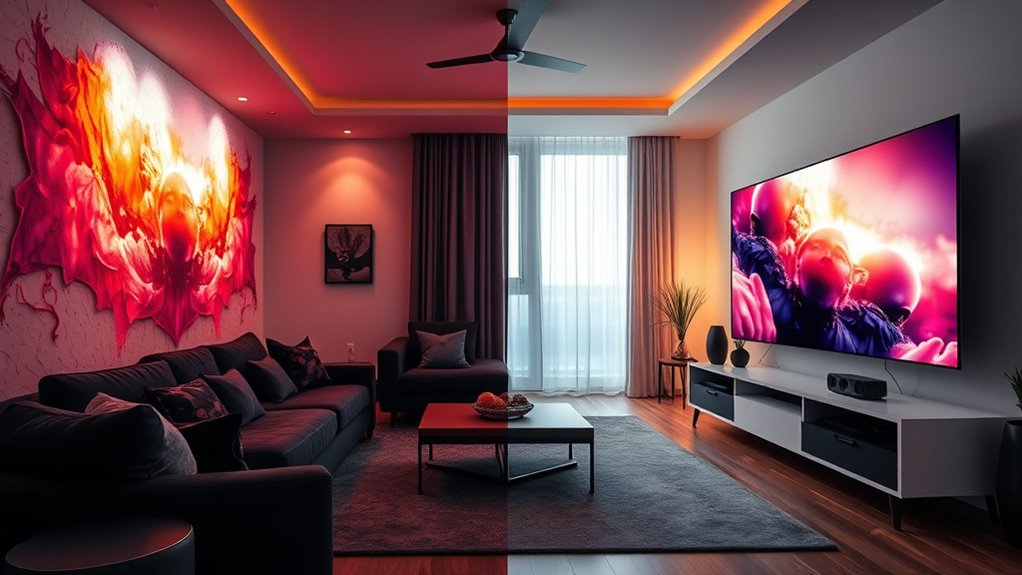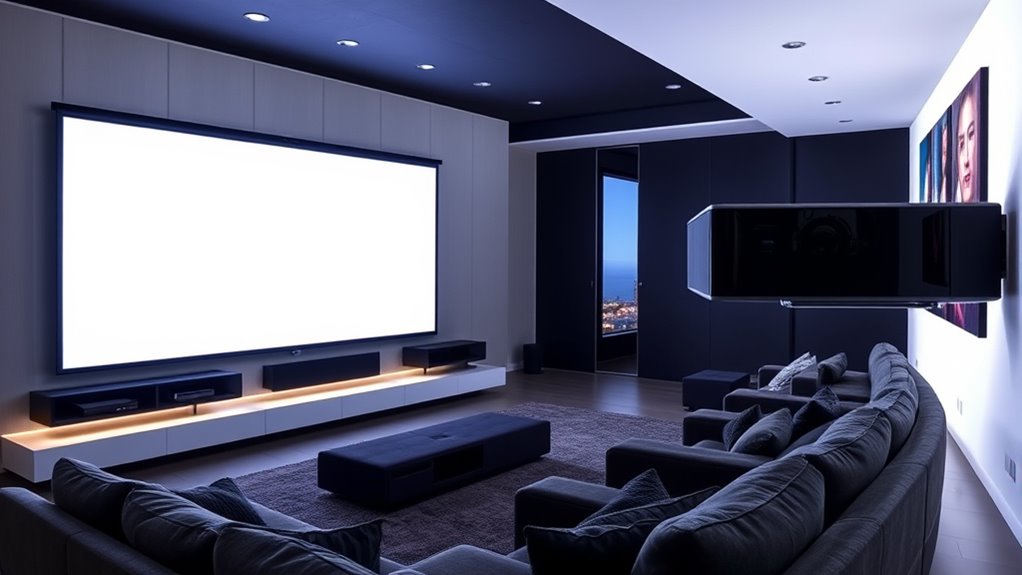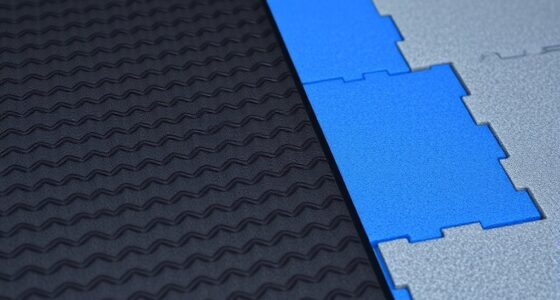If you’re choosing between a home theater projector and a large TV, consider that projectors can deliver massive screens for a lower cost, creating a true cinematic experience, especially in dark rooms. However, their picture quality drops in bright environments and they require regular maintenance. Large TVs provide bright, sharp images instantly, ideal for well-lit spaces, but they tend to be more expensive per inch. Stay with us to explore which option suits your space and budget best.
Key Takeaways
- Projectors offer larger screen sizes at a lower cost per inch, ideal for immersive cinema experiences.
- Large TVs provide brighter images and better contrast, especially suitable for well-lit rooms.
- TVs deliver sharper images at smaller sizes due to higher pixel density, while projectors excel at huge screens in dark environments.
- Projectors require careful setup, room darkening, and maintenance, whereas TVs are easier to install and more durable.
- Portability favors projectors, while large TVs are more permanent and less sensitive to ambient room lighting.

When choosing between a home theater projector and a large TV, it’s important to contemplate how each option enhances your viewing experience. Projectors can display images ranging from 100 to 300 inches diagonally, far surpassing typical TV sizes. In contrast, TVs generally max out at around 85 inches for consumer models, with 85 inches being the largest 4K option readily available. This means a projector can create a truly cinema-like environment right in your living room, offering a larger, more immersive display. You have the flexibility to customize the screen size depending on your space and setup, which is a noteworthy advantage. Larger screens foster a more engaging, theater-style experience, perfect for movie nights or gaming. On the other hand, TV screens are more limited in size but deliver consistently sharp images thanks to higher pixel density, ensuring clarity even at smaller sizes.
Projectors offer larger, customizable screens for a cinematic experience, while TVs provide sharp images at smaller sizes.
When it comes to picture quality and resolution, both projectors and modern TVs can provide 4K resolution. However, the higher pixel density on smaller screens means TVs generally produce sharper images. As the screen size increases on projectors, the pixel density drops, making images appear less sharp compared to a TV of similar resolution. Brightness is another factor; TVs have internally lit screens that produce high brightness and contrast, making them suitable for brightly lit rooms. Projectors, however, tend to produce lower brightness, which can diminish image quality in ambient light. They perform best in dark or dim environments where contrast and color accuracy are preserved. This difference influences where and how you use each device, depending on your room’s lighting conditions. Ambient light performance is a key consideration because it significantly impacts image visibility and quality in real-world settings.
Cost is another important consideration. Projectors typically offer a lower cost per inch of screen size, making large displays more affordable than equivalent-sized TVs. While 4K projectors range from about $1,000 to $4,000 depending on features, large 4K TVs of comparable size can be markedly more expensive, sometimes costing thousands more per inch. Keep in mind, though, that projectors often require additional investments such as screens, mounts, and proper room darkening, which can add to the overall cost. Setup and portability also differ; projectors require careful placement, alignment, and sometimes mounting, demanding more effort upfront. They are generally more portable, easily moved between rooms or locations. Conversely, TVs are straightforward to set up—just plug them in and mount or place on a stand—and are less sensitive to room lighting conditions.
Durability and maintenance vary as well. Projectors may need routine lamp or bulb replacements and regular cleaning to maintain image quality over time. TVs tend to have longer lifespans without the need for consumable replacements, maintaining consistent image quality throughout their life. Overall, your choice depends on your priorities—whether you value screen size and immersion, picture sharpness, affordability, or ease of use.
Frequently Asked Questions
Which Option Offers Better Picture Quality in Bright Rooms?
In bright rooms, a large TV offers superior picture quality because it provides higher brightness levels, often over 1,000 nits, which helps images stay vivid and sharp despite ambient light. You won’t need to worry about dimming the lights or adjusting settings. Projectors struggle with ambient light, causing washed-out images and reduced contrast, making TVs the better choice for maintaining clarity and color vibrancy in well-lit spaces.
How Do Installation Costs Compare Between Projectors and Large TVS?
Imagine installing a home theater system; you find that a projector setup costs around $1,350, including a high-lumen model and speakers, while a large TV can cost over $2,750 to install. Typically, projectors are less expensive initially due to simpler mounting and fewer integrated components. However, keep in mind that additional costs for screens, mounts, and maintenance might affect your total budget, often making projectors a more cost-effective choice.
What Is the Typical Lifespan of a Projector Compared to a Large TV?
You want to know how long a projector lasts compared to a large TV. Typically, projectors last about 5 to 10 years, depending on usage and maintenance, with LED and laser models lasting longer. Large TVs usually have a lifespan of over 10 years, thanks to durable display technology and less need for maintenance. While projectors may need more attention, TVs tend to be more long-lasting and reliable over time.
Are There Any Health Concerns Associated With Projectors or Large TVS?
Health concerns with projectors and large TVs are like shadows lurking behind the bright lights. You might experience eye strain, dryness, or fatigue from blue light exposure, especially with prolonged use. Projectors, being indirect light sources, can reduce eye discomfort compared to TVs, which emit direct light. Taking regular breaks, adjusting brightness, and maintaining proper distance can help keep your eyes comfortable and safe during screen time.
How Do Maintenance Requirements Differ Between Projectors and Large TVS?
You’ll find that maintaining a projector is more involved than caring for a large TV. Projectors need frequent cleaning of lenses and air vents, careful handling, and protection from dust, humidity, and temperature fluctuations. They also require surge protectors and proper ventilation. In contrast, large TVs need less frequent dusting and cleaning, with simpler maintenance routines, making them generally easier and less costly to keep in good condition.
Conclusion
Ultimately, whether you choose a home theater projector or a large TV depends on your space and style. Projectors give you that cinematic feel, but you’ll need a dark room—no back to the future tech here. A large TV offers convenience and bright images, perfect for modern living rooms. Think of it like choosing between a vintage vinyl record or streaming your favorite playlist—both have charm, but your choice shapes your home’s vibe.









